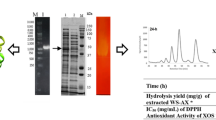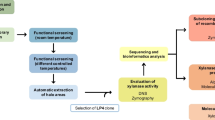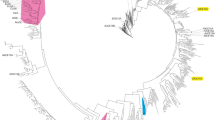Abstract
Talaromyces cellulolyticus is a promising fungus for providing a cellulase preparation suitable for the hydrolysis of lignocellulosic material, although its mannan-degrading activities are insufficient. In the present study, three core mannanolytic enzymes, including glycosyl hydrolase family 5–7 (GH5–7) β-mannanase (Man5A), GH27 α-galactosidase, and GH2 β-mannosidase, were purified from a culture supernatant of T. cellulolyticus grown with glucomannan, and the corresponding genes were identified based on their genomic sequences. Transcriptional analysis revealed that these genes were specifically induced by glucomannan. Two types of Man5A products, Man5A1 and Man5A2, were found as major proteins in the mannanolytic system. Man5A1 was devoid of a family 1 carbohydrate-binding module (CBM1) at the N-terminus, whereas Man5A2 was devoid of both CBM1 and Ser/Thr-rich linker region. The physicochemical and catalytic properties of both Man5A1 and Man5A2 were identical to those of recombinant Man5A (rMan5A) possessing CBM1, except for the cellulose-binding ability. Man5A CBM1 had little effect on mannan hydrolysis of pretreated Hinoki cypress. The results suggest that an improvement in Man5A CBM1 along with the augmentation of identified mannanolytic enzyme components would aid in efficient hydrolysis of softwood using T. cellulolyticus cellulase preparation.






Similar content being viewed by others
References
Moreira, L. R., & Filho, E. X. (2008). An overview of mannan structure and mannan-degrading enzyme systems. Applied Microbiology and Biotechnology, 79(2), 165–178.
Srivastava, P. K., & Kapoor, M. (2017). Production, properties, and applications of endo-β-mannanases. Biotechnology Advances, 35(1), 1–19.
van Zyl, W. H., Rosea, S. H., Trollopeb, K., & Görgensb, J. F. (2010). Fungal β-mannanases: mannan hydrolysis, heterologous production and biotechnological applications. Process Biochemistry, 45, 1203–1213.
Singh, S., Singh, G., & Arya, S. K. (2018). Mannans: an overview of properties and application in food products. International Journal of Biological Macromolecules, 119, 79–95.
Dotsenko, G. S., Semenova, M. V., Sinitsyna, O. A., Hinz, S. W., Wery, J., Zorov, I. N., Kondratieva, E. G., & Sinitsyn, A. P. (2012). Cloning, purification, and characterization of galactomannan-degrading enzymes from Myceliophthora thermophila. Biochemistry (Moscow), 77(11), 1303–1311.
Malgas, S., van Dyk, J. S., & Pletschke, B. I. (2015). A review of the enzymatic hydrolysis of mannans and synergistic interactions between β-mannanase, β-mannosidase and α-galactosidase. World Journal of Microbiology and Biotechnology, 31(8), 1167–1175.
Aulitto, M., Fusco, S., Limauro, D., Fiorentino, G., Bartolucci, S., & Contursi, P. (2019). Galactomannan degradation by thermophilic enzymes: a hot topic for biotechnological applications. World Journal of Microbiology and Biotechnology, 35(2), 32.
Aspeborg, H., Coutinho, P. M., Wang, Y., Brumer 3rd, H., & Henrissat, B. (2012). Evolution, substrate specificity and subfamily classification of glycoside hydrolase family 5 (GH5). BMC Evolutionary Biology, 12(1), 186.
Ademark, P., Varga, A., Medve, J., Harjunpää, V., Drakenberg, T., Tjerneld, F., & Stålbrand, H. (1998). Softwood hemicellulose-degrading enzymes from Aspergillus niger: purification and properties of a β-mannanase. Journal of Biotechnology, 63(3), 199–210.
Tenkanen, M., Makkonen, M., Perttula, M., Viikari, L., & Teleman, A. (1997). Action of Trichoderma reesei mannanase on galactoglucomannan in pine kraft pulp. Journal of Biotechnology, 57(1–3), 191–204.
Rosengren, A., Reddy, S. K., Sjöberg, J. S., Aurelius, O., Logan, D. T., Kolenová, K., & Stålbrand, H. (2014). An Aspergillus nidulans β-mannanase with high transglycosylation capacity revealed through comparative studies within glycosidase family 5. Applied Microbiology and Biotechnology, 98(24), 10091–10104.
von Freiesleben, P., Spodsberg, N., Stenbæk, A., Stålbrand, H., Krogh, K., & Meyer, A. S. (2018). Boosting of enzymatic softwood saccharification by fungal GH5 and GH26 endomannanases. Biotechnology for Biofuels, 11(1), 194.
Jørgensen, H., Sanadi, A. R., Felby, C., Lange, N. E. K., Fischer, M., & Ernst, S. (2010). Production of ethanol and feed by high dry matter hydrolysis and fermentation of palm kernel press cake. Applied Biochemistry and Biotechnology, 161(1–8), 318–332.
Inoue, H., Yano, S., & Sawayama, S. (2015). Effect of β-mannanase and β-mannosidase supplementation on the total hydrolysis of softwood polysaccharides by the Talaromyces cellulolyticus cellulase system. Applied Biochemistry and Biotechnology, 176(6), 1673–1686.
Hägglund, P., Eriksson, T., Collén, A., Nerinckx, W., Claeyssens, M., & Stålbrand, H. (2003). A cellulose-binding module of the Trichoderma reesei β-mannanase Man5A increases the mannan-hydrolysis of complex substrates. Journal of Biotechnology, 101(1), 37–48.
Benech, R. O., Li, X. M., Patton, D., Powlowski, J., Storms, R., Bourbonnais, R., Paice, M., & Tsang, A. (2007). Recombinant expression, characterization, and pulp prebleaching property of a Phanerochaete chrysosporium endo-β-1,4-mannanase. Enzyme and Microbial Technology, 41(6–7), 740–747.
Lu, H., Luo, H., Shi, P., Huang, H., Meng, K., Yang, P., & Yao, B. (2014). A novel thermophilic endo-β-1,4-mannanase from Aspergillus nidulans XZ3: functional roles of carbohydrate-binding module and Thr/Ser-rich linker region. Applied Microbiology and Biotechnology, 98(5), 2155–2163.
Wang, C., Luo, H., Niu, C., Shi, P., Huang, H., Meng, K., Bai, Y., Wang, K., Hua, H., & Yao, B. (2015). Biochemical characterization of a thermophilic β-mannanase from Talaromyces leycettanus JCM12802 with high specific activity. Applied Microbiology and Biotechnology, 99(3), 1217–1228.
Tang, C. D., Li, J. F., Wei, X. H., Min, R., Gao, S. J., Wang, J. Q., Yin, X., & Wu, M. C. (2013). Fusing a carbohydrate-binding module into the Aspergillus usamii β-mannanase to improve its thermostability and cellulose-binding capacity by in silico design. PLoS One, 8(5), e64766.
Wang, J., Zeng, D., Liu, G., Wang, S., & Yu, S. (2014). Truncation of a mannanase from Trichoderma harzianum improves its enzymatic properties and expression efficiency in Trichoderma reesei. Journal of Industrial Microbiology and Biotechnology, 41(1), 125–133.
Ma, L., Ma, Q., Cai, R., Zong, Z., Du, L., Guo, G., Zhang, Y., & Xiao, D. (2018). Effect of β-mannanase domain from Trichoderma reesei on its biochemical characters and synergistic hydrolysis of sugarcane bagasse. Journal of the Science of Food and Agriculture, 98(7), 2540–2547.
Liuzzi, F., Mastrolitti, S., & De Bari, I. (2019). Hydrolysis of corn stover by Talaromyces cellulolyticus enzymes: evaluation of the residual enzymes activities through the process. Applied Biochemistry and Biotechnology, 188(3), 690–705.
Inoue, H., Decker, S. R., Taylor, L. E., Yano, S., & Sawayama, S. (2014). Identification and characterization of core cellulolytic enzymes from Talaromyces cellulolyticus (formerly Acremonium cellulolyticus) critical for hydrolysis of lignocellulosic biomass. Biotechnology for Biofuels, 7(1), 151.
Fujii, T., Inoue, H., Yano, S., & Sawayama, S. (2018). Strain improvement for industrial production of lignocellulolytic enzyme by Talaromyces cellulolyticus. In X. Fang & Y. Qu (Eds.), Fungal cellulolytic enzymes (pp. 58–68). Singapore: Springer.
Nakamichi, Y., Fujii, T., Fouquet, T., Matsushika, A., & Inoue, H. (2019). GH30-7 endoxylanase C from the filamentous fungus Talaromyces cellulolyticus. Applied and Environmental Microbiology, 85, e01442–e01419.
Fujii, T., Fang, X., Inoue, H., Murakami, K., & Sawayama, S. (2009). Enzymatic hydrolyzing performance of Acremonium cellulolyticus and Trichoderma reesei against three lignocellulosic materials. Biotechnology for Biofuels, 2(1), 24.
Yamanobe, T., Mitsuishi, Y., & Takasaki, Y. (1987). Isolation of a cellulolytic enzyme producing microorganism, culture conditions and some properties of the enzymes. Agricultural and Biological Chemistry, 51(1), 65–74.
Inoue, H., Fujii, T., Yoshimi, M., Taylor, L. E., Decker, S. R., Kishishita, S., Nakabayashi, M., & Ishikawa, K. (2013). Construction of a starch-inducible homologous expression system to produce cellulolytic enzymes from Acremonium cellulolyticus. Journal of Industrial Microbiology and Biotechnology, 40(8), 823–830.
Fujii, T., Iwata, K., Murakami, K., Yano, S., & Sawayama, S. (2012). Isolation of uracil auxotrophs of the fungus Acremonium cellulolyticus and the development of a transformation system with the pyrF gene. Bioscience, Biotechnology, and Biochemistry, 76(2), 245–249.
Zorn, H., & Li, Q. X. (2017). Trends in food enzymology. Journal of Agricultural and Food Chemistry, 65(1), 4–5.
Kemmer, G., & Keller, S. (2010). Nonlinear least-squares data fitting in Excel spreadsheets. Nature Protocols, 5(2), 267–281.
Fujii, T., Inoue, H., & Ishikawa, K. (2013). Enhancing cellulase and hemicellulase production by genetic modification of the carbon catabolite repressor gene, creA, in Acremonium cellulolyticus. AMB Express, 3(1), 73.
Fujii, T., Murakami, K., & Sawayama, S. (2010). Cellulase hyperproducing mutants derived from the fungus Trichoderma reesei QM9414 produced large amounts of cellulase at the enzymatic and transcriptional levels. Bioscience, Biotechnology, and Biochemistry, 74(2), 419–422.
Watanabe, M., Inoue, H., Inoue, B., Yoshimi, M., Fujii, T., & Ishikawa, K. (2014). Xylanase (GH11) from Acremonium cellulolyticus: homologous expression and characterization. AMB Express, 4(1), 27.
Kumagai, A., Kawamura, S., Lee, S. H., Endo, T., Rodriguez Jr., M., & Mielenz, J. R. (2014). Simultaneous saccharification and fermentation and a consolidated bioprocessing for Hinoki cypress and Eucalyptus after fibrillation by steam and subsequent wet-disk milling. Bioresource Technology, 162, 89–95.
Ademark, P., de Vries, R. P., Hägglund, P., Stålbrand, H., & Visser, J. (2001). Cloning and characterization of Aspergillus niger genes encoding an α-galactosidase and a β-mannosidase involved in galactomannan degradation. European Journal of Biochemistry, 268(10), 2982–2990.
Do, B. C., Dang, T. T., Berrin, J. G., Haltrich, D., To, K. A., Sigoillot, J. C., & Yamabhai, M. (2009). Cloning, expression in Pichia pastoris, and characterization of a thermostable GH5 mannan endo-1,4-β-mannosidase from Aspergillus niger BK01. Microbial Cell Factories, 8, 59.
Coradetti, S. T., Craig, J. P., Xiong, Y., Shock, T., Tian, C., & Glass, N. L. (2012). Conserved and essential transcription factors for cellulase gene expression in ascomycete fungi. Proceedings of the National Academy of Sciences of the United States of America, 109(19), 7397–7402.
Ogawa, M., Kobayashi, T., & Koyama, Y. (2012). ManR, a novel Zn(II)2Cys6 transcriptional activator, controls the β-mannan utilization system in Aspergillus oryzae. Fungal Genetics and Biology, 49(12), 987–995.
Craig, J. P., Coradetti, S. T., Starr, T. L., & Glass, N. L. (2015). Direct target network of the Neurospora crassa plant cell wall deconstruction regulators CLR-1, CLR-2, and XLR-1. mBio, 6(5), e01452–e01415.
Li, N., Kunitake, E., Aoyama, M., Ogawa, M., Kanamaru, K., Kimura, M., Koyama, Y., & Kobayashi, T. (2016). McmA-dependent and -independent regulatory systems governing expression of ClrB-regulated cellulase and hemicellulase genes in Aspergillus nidulans. Molecular Microbiology, 102(5), 810–826.
Ogawa, M., Kobayashi, T., & Koyama, Y. (2013). ManR, a transcriptional regulator of the β-mannan utilization system, controls the cellulose utilization system in Aspergillus oryzae. Bioscience, Biotechnology, and Biochemistry, 77(2), 426–429.
Fujii, T., Inoue, H., & Ishikawa, K. (2015). Decreased cellulase and xylanase production in the fungus Talaromyces cellulolyticus by disruption of tacA and tctA genes, encoding putative zinc finger transcriptional factors. Applied Biochemistry and Biotechnology, 175(6), 3218–3229.
Liao, H., Li, S., Zheng, H., Wei, Z., Liu, D., Raza, W., Shen, Q., & Xu, Y. (2014). A new acidophilic thermostable endo-1,4-β-mannanase from Penicillium oxalicum GZ-2: cloning, characterization and functional expression in Pichia pastoris. BMC Biotechnology, 14(1), 90.
Kansarn, S., Nihira, T., Hashimoto, E., Suzuki, M., Kono, T., & Okada, G. (2000). Purification and properties of two endo-cellulases from Acremonium cellulolyticus. Journal of Applied Glycoscience, 47(3–4), 293–302.
Nihira, T., Kansarn, S., Kono, T., & Okada, G. (2001). Purification and properties of three endo-xylanases from Acremonium cellulolyticus. Journal of Applied Glycoscience, 48(1), 45–54.
Chen, X. L., Cao, Y. H., Ding, Y. H., Lu, W. Q., & Li, D. F. (2007). Cloning, functional expression and characterization of Aspergillus sulphureus β-mannanase in Pichia pastoris. Journal of Biotechnology, 128(3), 452–461.
Wang, C., Zhang, J., Wang, Y., Niu, C., Ma, R., Wang, Y., Bai, Y., Luo, H., & Yao, B. (2016). Biochemical characterization of an acidophilic β-mannanase from Gloeophyllum trabeum CBS900.73 with significant transglycosylation activity and feed digesting ability. Food Chemistry, 197(Pt A), 474–481.
Pham, T. A., Berrin, J. G., Record, E., To, K. A., & Sigoillot, J. C. (2010). Hydrolysis of softwood by Aspergillus mannanase: role of a carbohydrate-binding module. Journal of Biotechnology, 148(4), 163–170.
Acknowledgments
The authors are grateful to Dr. Akio Kumagai (National Institute of Advanced Industrial Science and Technology) for helpful discussions.
Funding
This work was financially supported by a Basic Research Funding grant from the National Institute of Advanced Industrial Science and Technology.
Author information
Authors and Affiliations
Contributions
All authors contributed to the study conception and design. K.U, S.K, and H.I prepared and characterized the enzymes. T.F characterized the gene expression. M.W and H.I coordinated the study. All authors contributed to the writing of this manuscript and approved the final version.
Corresponding author
Ethics declarations
Conflict of Interest
The authors declare that they have no conflict of interest.
Additional information
Publisher’s Note
Springer Nature remains neutral with regard to jurisdictional claims in published maps and institutional affiliations.
Electronic Supplementary Material
ESM 1
(PDF 391 KB)
Rights and permissions
About this article
Cite this article
Uechi, K., Watanabe, M., Fujii, T. et al. Identification and Biochemical Characterization of Major β-Mannanase in Talaromyces cellulolyticus Mannanolytic System. Appl Biochem Biotechnol 192, 616–631 (2020). https://doi.org/10.1007/s12010-020-03350-6
Received:
Accepted:
Published:
Issue Date:
DOI: https://doi.org/10.1007/s12010-020-03350-6




